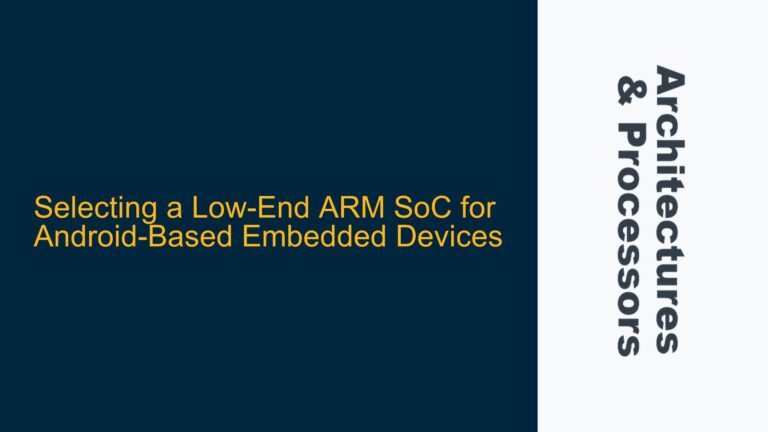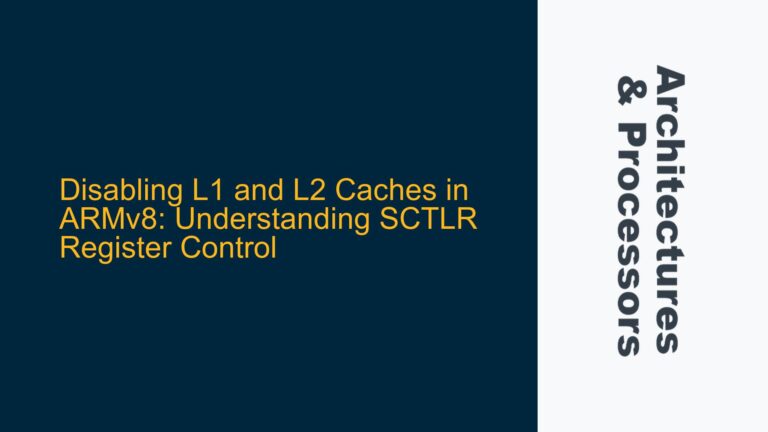ARM Cortex-A53 Generic Timer and System Counter Overview
The ARM Cortex-A53 processor, part of the ARMv8-A architecture, incorporates a sophisticated timing mechanism known as the Generic Timer. This timer is crucial for various system operations, including scheduling, synchronization, and timekeeping across multiple cores. The Generic Timer operates in conjunction with the System Counter, a global counter that provides a consistent time reference across all processors in a multi-core system.
The System Counter is a high-resolution, monotonically increasing counter that increments at a fixed frequency, typically derived from an external clock source. This counter is shared across all cores in the system, ensuring that all processors have a synchronized view of time. The System Counter’s primary purpose is to provide a common timebase for the Generic Timers in each core, enabling precise timing and synchronization across the entire system.
The Generic Timer, on the other hand, is a set of timers implemented within each core. These timers compare the current value of the System Counter with a predefined compare value. When the System Counter’s value matches or exceeds the compare value, the timer generates an interrupt, signaling that a specific time interval has elapsed. This mechanism is essential for tasks such as task scheduling in operating systems, where precise timing is required to ensure fair and efficient CPU resource allocation.
The Generic Timer also supports virtualization, allowing hypervisors to create virtual timers for virtual machines. This is achieved by introducing a virtual counter, which is derived from the physical System Counter but can be adjusted or offset by the hypervisor. Virtual timers compare against this virtual counter, enabling virtual machines to have their own independent timing mechanisms without directly accessing the physical System Counter.
System Counter Initialization and Physical vs. Virtual Counters
The System Counter is typically initialized during the system boot process. It is configured to start counting from a specific value, often zero, and increments at a fixed frequency determined by the system’s clock source. The System Counter is memory-mapped, meaning that its control registers are accessible via specific memory addresses. These registers allow software to initialize the counter, read its current value, and configure its behavior.
One of the key features of the System Counter is that it is not expected to be stopped once it has been started. This is because the System Counter serves as the primary time reference for the entire system, and stopping it would disrupt the timing of all dependent components, including the Generic Timers in each core. However, in some specialized scenarios, such as low-power modes, the System Counter may be paused or its frequency adjusted to conserve energy.
The distinction between physical and virtual counters is particularly important in systems that support virtualization. The physical counter refers to the actual System Counter, which provides a global time reference for the entire system. In contrast, the virtual counter is a software-generated counter that is used by virtual machines. The virtual counter is derived from the physical counter but can be modified by the hypervisor to create a virtualized timing environment for each virtual machine.
Virtual counters allow virtual machines to operate with their own independent timing mechanisms, even though they are running on the same physical hardware. This is crucial for ensuring that virtual machines can accurately measure time intervals and schedule tasks without being affected by the timing of other virtual machines or the underlying physical hardware. The hypervisor manages the relationship between the physical and virtual counters, ensuring that each virtual machine has a consistent and accurate view of time.
Troubleshooting Generic Timer and System Counter Issues
When working with the ARM Cortex-A53 Generic Timer and System Counter, several issues can arise that may affect the system’s timing and synchronization. These issues can be broadly categorized into initialization problems, counter synchronization issues, and virtualization-related timing discrepancies.
Initialization problems often occur when the System Counter is not properly configured during the boot process. This can result in the counter starting from an incorrect value or incrementing at an unexpected frequency. To resolve this, it is essential to ensure that the System Counter’s control registers are correctly programmed during system initialization. This includes setting the initial count value, configuring the clock source, and enabling the counter.
Counter synchronization issues can arise in multi-core systems where each core’s Generic Timer relies on the System Counter for timing. If the System Counter is not properly synchronized across all cores, it can lead to timing discrepancies that affect task scheduling and other time-sensitive operations. To address this, it is important to ensure that the System Counter is consistently accessible and that all cores are correctly configured to use the same System Counter.
Virtualization-related timing discrepancies can occur when the hypervisor does not properly manage the relationship between the physical and virtual counters. This can result in virtual machines experiencing incorrect timing, leading to issues such as missed deadlines or incorrect time measurements. To mitigate this, the hypervisor must accurately maintain the virtual counters for each virtual machine, ensuring that they are correctly derived from the physical System Counter and adjusted as needed.
In summary, the ARM Cortex-A53 Generic Timer and System Counter are critical components for ensuring accurate timing and synchronization in multi-core systems. Proper initialization, configuration, and management of these components are essential for maintaining system stability and performance. By understanding the relationship between the System Counter, Generic Timer, and virtual counters, developers can effectively troubleshoot and resolve timing-related issues in ARM-based systems.






